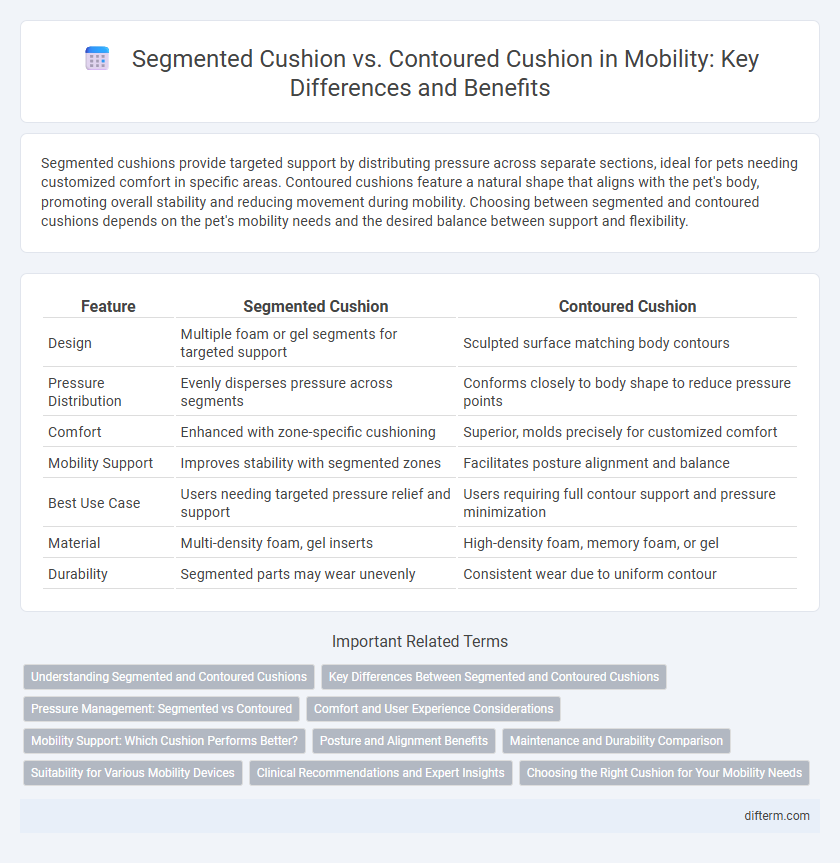Segmented cushions provide targeted support by distributing pressure across separate sections, ideal for pets needing customized comfort in specific areas. Contoured cushions feature a natural shape that aligns with the pet's body, promoting overall stability and reducing movement during mobility. Choosing between segmented and contoured cushions depends on the pet's mobility needs and the desired balance between support and flexibility.
Table of Comparison
| Feature | Segmented Cushion | Contoured Cushion |
|---|---|---|
| Design | Multiple foam or gel segments for targeted support | Sculpted surface matching body contours |
| Pressure Distribution | Evenly disperses pressure across segments | Conforms closely to body shape to reduce pressure points |
| Comfort | Enhanced with zone-specific cushioning | Superior, molds precisely for customized comfort |
| Mobility Support | Improves stability with segmented zones | Facilitates posture alignment and balance |
| Best Use Case | Users needing targeted pressure relief and support | Users requiring full contour support and pressure minimization |
| Material | Multi-density foam, gel inserts | High-density foam, memory foam, or gel |
| Durability | Segmented parts may wear unevenly | Consistent wear due to uniform contour |
Understanding Segmented and Contoured Cushions
Segmented cushions feature distinct, separated sections designed to distribute pressure evenly and enhance airflow, reducing the risk of pressure sores for wheelchair users. Contoured cushions contour to the user's body shape, providing personalized support and promoting proper posture by aligning the pelvis and spine. Understanding the differences between segmented and contoured cushions helps in selecting the optimal support and pressure relief tailored to individual mobility needs.
Key Differences Between Segmented and Contoured Cushions
Segmented cushions feature separate foam sections designed to target pressure relief and enhance airflow, promoting better weight distribution for users with specific pressure mapping needs. Contoured cushions provide a continuous, molded surface that aligns with the body's natural curves, offering uniform support and stability, ideal for individuals requiring posture alignment and comfort. Understanding these key differences aids in selecting the optimal cushion for mobility devices, balancing pressure management and ergonomic support.
Pressure Management: Segmented vs Contoured
Segmented cushions feature distinct sections designed to distribute pressure evenly and enhance airflow, reducing the risk of pressure sores in mobility users. Contoured cushions mold to the shape of the body, providing customized support by aligning pressure points and improving posture stability. Effective pressure management relies on the individual's needs, with segmented cushions offering better ventilation and pressure redistribution, while contoured cushions deliver targeted cushioning for sensitive areas.
Comfort and User Experience Considerations
Segmented cushions offer customizable support by individually adjusting pressure points, enhancing comfort for users with varying body contours and reducing the risk of pressure sores. Contoured cushions provide a uniform, ergonomic shape designed to evenly distribute weight and promote natural posture alignment, improving overall stability and user experience. Selecting between segmented and contoured cushions depends on individual needs for personalized pressure relief versus consistent anatomical support in mobility seating solutions.
Mobility Support: Which Cushion Performs Better?
Segmented cushions provide targeted support by distributing pressure evenly across distinct sections, reducing the risk of pressure sores and improving stability for users with varied mobility needs. Contoured cushions are designed to match the natural shape of the body, offering enhanced postural support and promoting proper spinal alignment, which is crucial for maintaining mobility and preventing discomfort. In terms of mobility support, contoured cushions generally perform better by providing customized comfort and improved weight distribution, while segmented cushions excel in adaptability for dynamic movements.
Posture and Alignment Benefits
Segmented cushions offer individualized support by distributing pressure evenly across distinct sections, promoting improved posture and spinal alignment for wheelchair users. Contoured cushions provide continuous, molded support that aligns with the natural curves of the body, enhancing stability and reducing muscle fatigue. Both cushion types contribute to maintaining optimal posture, but segmented cushions excel in pressure relief while contoured cushions prioritize anatomical alignment.
Maintenance and Durability Comparison
Segmented cushions feature individual foam sections that can be replaced separately, simplifying maintenance and extending overall lifespan compared to contoured cushions, which are molded as a single piece and may require full replacement when damaged. The modular design of segmented cushions allows targeted cleaning and repairs, enhancing durability in high-use mobility devices like wheelchairs. Contoured cushions, while offering superior ergonomic support, often present challenges in upkeep due to their fixed shape and integrated materials, potentially increasing long-term maintenance costs.
Suitability for Various Mobility Devices
Segmented cushions offer enhanced pressure relief and flexibility, making them suitable for a wide range of mobility devices, including manual and power wheelchairs. Contoured cushions provide targeted support and stability, ideal for users with specific postural needs or those requiring extra lateral support in devices like reclining wheelchairs or specialized pediatric models. Selecting the appropriate cushion depends on the user's mobility level, posture, and the type of wheelchair or mobility equipment utilized.
Clinical Recommendations and Expert Insights
Segmented cushions provide targeted pressure relief by distributing weight evenly, making them suitable for patients with moderate risk of pressure ulcers. Contoured cushions offer enhanced anatomical support, promoting optimal posture and spinal alignment, which is recommended for individuals with advanced musculoskeletal conditions. Clinical guidelines emphasize selecting cushions based on patient-specific mobility levels and pressure distribution needs to optimize comfort and prevent tissue damage.
Choosing the Right Cushion for Your Mobility Needs
Segmented cushions offer customizable support by distributing pressure evenly across separate foam or gel sections, ideal for users requiring targeted pressure relief and enhanced airflow. Contoured cushions provide a uniform, molded shape that promotes proper posture and spinal alignment, beneficial for users with consistent seating needs and postural challenges. Selecting the right cushion depends on individual mobility requirements, pressure management goals, and the level of support needed for prolonged sitting periods.
Segmented cushion vs Contoured cushion Infographic

 difterm.com
difterm.com